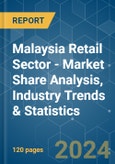The Malaysia Retail Market size is estimated at USD 89.66 billion in 2024, and is expected to reach USD 119.64 billion by 2029, growing at a CAGR of 5.94% during the forecast period (2024-2029).
The Malaysian retail industry has been one of the largest contributing sectors to the country's gross domestic product (GDP) for the past decades. Several national and international brands have been performing in the country with a broad range of retail outlets across the nation. Despite several new store launches and a broad network of stores, the retail industry has registered a slow rate during the study period, which was drastically dropped during 2020 owing to the COVID-19 pandemic. The movement control order (MCO) restricted the public movement, and the lockdown, which was originally expected to last for two weeks in March 2020 and extended to mid-May 2020, has resulted in a sudden drop in total revenue generated from the retail sector. The sector contracted by around 16% in 2020. Some of the retail segments recorded a great contract, including double-digit contractions during 2020, which includes apparel, footwear, fashion accessories, and others. Similarly, one of the largest distribution channel segments - the hypermarkets, supermarkets, and convenience stores - recorded a drop in the total sales generated.
This product will be delivered within 2 business days.
The Malaysian retail industry has been one of the largest contributing sectors to the country's gross domestic product (GDP) for the past decades. Several national and international brands have been performing in the country with a broad range of retail outlets across the nation. Despite several new store launches and a broad network of stores, the retail industry has registered a slow rate during the study period, which was drastically dropped during 2020 owing to the COVID-19 pandemic. The movement control order (MCO) restricted the public movement, and the lockdown, which was originally expected to last for two weeks in March 2020 and extended to mid-May 2020, has resulted in a sudden drop in total revenue generated from the retail sector. The sector contracted by around 16% in 2020. Some of the retail segments recorded a great contract, including double-digit contractions during 2020, which includes apparel, footwear, fashion accessories, and others. Similarly, one of the largest distribution channel segments - the hypermarkets, supermarkets, and convenience stores - recorded a drop in the total sales generated.
Malaysian Retail Market Trends
Food and Beverages Segment has been Contributing a Major Share to the Market Revenue
Malaysia's most significant F&B exports are in the oils and fats category, particularly palm oil-based products, for which the country is one of the largest exporters in the world. The country is also heavily dependent on imports of many staples, including rice, most meat, and seafood, for domestic consumption. The Malaysian food industry is as diverse as the cultures in Malaysia, with a wide range of processed food as per the Asian taste. This industry is predominantly Malaysian-owned, dominated by small and medium-scale companies (SMEs). Besides the SMEs, there are notable foreign companies and MNCs producing processed food products in Malaysia. Despite the challenges due to the ongoing pandemic, the segment recorded growth in transactions due to its contact demand, and the players expanded their online distribution to cope with the demand.Revenues from Physical Retail Distribution Channels Dropped During 2020 Due to COVID-19
Owing to the lockdown measures and physical distancing norms, the physical retailing in Malaysia contracted largely and recorded a drop in revenue quarter by quarter in 2020. Physical retailing recorded a sudden dip during the late first quarter of 2020. The Malaysian retail sector recorded the largest dip in sales during the second quarter of 2020, with a negative growth rate of 30.9% in retail sales when compared to the same period in 2019. Retail Group Malaysia (RGM) announced several retail outlets have been facing severe revenue drop, which led to the closure of the stores. As of March 2021, the closure of around 15% stores of the total retail stores nationwide. However, the online channel of distribution is strengthening in the country. The dip in various forms of physical retailing, including hypermarkets, supermarkets, convenience stores, specialty stores, franchise, branded, and multi-brand stores, is restricting the market to record growth in revenue transactions.Malaysian Retail Industry Overview
The report covers major international players operating in the Malaysian retail market. In terms of market share, few of the major players currently dominate the market. The organized retail market has been growing significantly with companies expanding stores and considering the business potential in new areas. Most of the unorganized retail outlets are increasingly being replaced with big retail hypermarkets, supermarkets, and other retail chains. This is expected to continue on a large scale during the forecast period, which may significantly lead to market growth.Additional Benefits:
- The market estimate (ME) sheet in Excel format
- 3 months of analyst support
This product will be delivered within 2 business days.
Table of Contents
1 INTRODUCTION
4 MARKET INSIGHTS AND DYNAMICS
5 MARKET SEGMENTATION
6 COMPETITIVE LANDSCAPE
Companies Mentioned (Partial List)
A selection of companies mentioned in this report includes, but is not limited to:
- Parkson Holdings Bhd
- Suiwah Corp. Bhd
- B.I.G. Store Sdn Bhd
- AEON Group
- 7-Eleven
- The Store Corp. Bhd
- Padini Holdings Bhd
- Isetan
- MJ Department Stores Sdn Bhd
- Tesco*
Methodology

LOADING...








